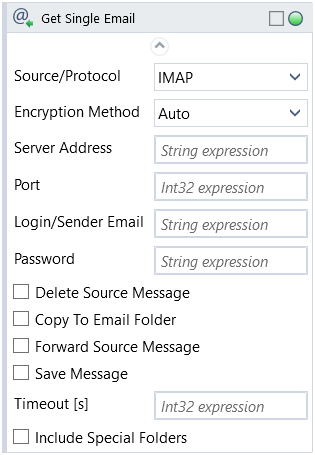Get Single E-mail
Activity checks the inbox of an indicated address and access the contents of the earliest email.
Activity does not differentiate between main inbox and inbox subfolders, if present.
To use the activity fill in the correct Login/Sender Email and Password for the email you want to access, as well as Protocol, Encryption method, Server Address and Port according to the email server’s settings.
Check Delete Source Message to delete the email after reading and be able to access the next one.
NOTE: IMAP protocol is recommended due to POP3 protocol's limitations. Deleting an email using POP3 protocol requires a full disconnect and some servers place a limit on number of re-connects allowed in certain timeframe.


Check Save Message to save downloaded message (with attachments, if present) to hard drive. Message will be saved at Target Save Folder. Check Short Message Folder Name if resulting file path is too long for Windows requirements.
If attachment file names contain illegal characters (brackets, slashes etc), they will be replaced with an underscore.
Activity returns Message ID, Message Received Timestamp, Title (message subject), Body (message contents), From (sender), To (original recipient), CC (additional recipients), Reply To (original reply recipient), Saved Message Path and Saved Attachments Paths (paths to where message and eventual attachments were saved to hard drive)
NOTE: It's recommended that the email address is reserved for robot use.


| Acquired Text | String | Output | text input by user |
|---|---|---|---|
| Alternative Scenario If Failed | Boolean | Input | checkbox; default is "on" |
| Application ID | String | Input | string expression from Azure Active Directory (applies to Microsoft services) or Google Cloud (applies to Google services) obtained after the application registration process |
| Body | String | Output | content of the message |
| CC | String | Output | address of the secondary recipient |
| Client Secret | String | Input | string expression from Google Cloud obtained after the application registration process |
| Delete from Server | Boolean | Input | checkbox; default is "off" |
| Display Name | Literal | Input | changes display name of the activity |
| Encryption Method | Dropdown | Input | select encryption method from the dropdown list |
| Exclude from Transaction Check | Boolean | Input | checkbox; default is "off" |
| From | String | Output | sender address |
| Local Folder Source Path | String | Input | path to the directory or file, where from you download email (Source: Directory/File) |
| Login | String | Input | login |
| Message Id | String | Output | message ID |
| Message Received Time Stamp | DateTime | Output | timestamp of received message |
| Password | String | Input | password (string expression) |
| Port | Int32 | Input | port number |
| Protocol | Dropdown | Input | select the appropriate option from the dropdown list |
| Provider | Dropdown | Input | select email provider from the dropdown list |
| Reply To | String[] | Output | original Reply To address |
| Result | Boolean | Output | returns a Boolean value. True if no error in activity, otherwise will return False |
| Result Code | Int32 | Output | Result Code will return 0 if there is no error in activity, otherwise in most cases will return 1. See the table of Extended Result Codes for more info |
| Save Message | Boolean | Input | checkbox; default is "off" |
| Saved Attachments Paths | String[] | Output | file paths to attachment files |
| Saved Message Path | String | Output | directory path to a file (file name and extension included) |
| Server Address | String | Input | address of e-mail server the robot logs on to |
| Short Message Folder Name | Boolean | Input | checkbox, default is "off" |
| Target Save Folder | String | Input | folder on computer disk where messages will be saved (direct path or variable) |
| Tenant ID | String | Input | string expression from Azure Active Directory obtained after the application registration process |
| Timeout [s] | Int32 | Input | set time in seconds to connect to email server |
| Title | String | Output | title of the message |
| To | String | Output | email address of recipient |
| Use OAuth | Boolean | Input | checkbox; default is "off" |